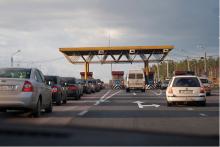Construction of a new toll link between the Russian capital of Moscow and the country's second-largest city, the port of St Petersburg, is due to start in 2012. Here, ITS International takes look at the project to date and the opportunities for foreign companies to get involved. The construction of a new toll link between the Russian capital Moscow and the country's second-largest city St Petersburg has a number of aims. It will lead to the creation of a high-speed vehicular link between the two which will

Construction of a new toll link between the Russian capital of Moscow and the country's second-largest city, the port of St Petersburg, is due to start in 2012. Here, ITS International takes look at the project to date and the opportunities for foreign companies to get involved.
The construction of a new toll link between the Russian capital Moscow and the country's second-largest city St Petersburg has a number of aims. It will lead to the creation of a high-speed vehicular link between the two which will be integrated into the international network of major transport corridors. The link will also improve road traffic safety in the region, increase capacity, alleviate congestion and reduce the costs of transportation.More formally, 'Constructing of the high-speed road Moscow - St. Petersburg on 58-684km (further used as toll road)' - to give the project its proper name - will improve the technical characteristics of Pan-European Transport Corridor No.9 and the International North-South Transport Corridor. (Following the route Helsinki - St. Petersburg - Moscow - Kiev - South-Eastern Europe, the former is one of 10 such corridors which were defined at the 2nd Pan-European Transport Conference, held on Crete in March 1994, as routes in Central and Eastern Europe which required major investment over the next 10-15 years; although these development corridors are distinct from the Trans-European Road Network, which includes all major, established routes in the European Union (EU), there are proposals to combine the two as most of the countries involved are now members of the EU. The latter connects the Indian Ocean and Persian Gulf via the Caspian Sea with St. Petersburg and Northern Europe).
The new scheme is also intended to improve traffic conditions on the existing M10 'Russia' federal road between Moscow and St. Petersburg - which for much of its length is only a two-lane highway, one lane in each direction - and influence socio-economic development in the adjacent territories by: taking transit cargo traffic off road segments situated in residential areas; creating the infrastructure conditions which will enable increased mobility for local populations and markets; decreasing the primary costs of transportation and traffic for transporters and shippers; developing international trade due to the more prompt delivery of freight to northwest seaports; and accelerating transport communication by improving access to the St. Petersburg seaport.
Project progress
TheAs a part of the pre-project phase, Tolltec carried out an extensive analysis of facilities around the world, visiting Italy, France, Spain, Serbia and Israel. During these visits, technical advisers from different countries actively shared their experience.
The company has thus far looked at various financial models for project realisation and this has included forecasting likely traffic levels. Based on a presumption of conservative GDP growth, the introduction of a fee level which will increase in line with the rate of inflation and road network development according to federal and regional programmes, a figure of 80,000 vehicles per day (taking into account the flow of vehicles in both directions) is anticipated by 2030. This is for the most intensively used section, in the Moscow region.
As with all modern projects, account must be taken of envionmental impact. This has been taken into consideration from the very beginning, not least because the new road will pass through two national parks - the Valdai Hills National Park in the Novgorod region and the Zavidovo National Park in the Moscow/Twer regions. All possible negative and positive impacts of the scheme's construction have been taken into account, according to Tolltec, and a range of environmentally compensating and diminishing measures are under consideration. This extends from the use during construction of modern, sustainable materials and methods to the implementation of ITS to smooth traffic flows and reduce the impact of incidents as well as to reduce emissions.
Where the last-mentioned is concerned, the road will be situated in what is commonly referred to as 'European Russia'. Much work has already gone into making road operations interoperable in Western Europe. This includes cross-border sharing of real-time operations data and the interoperability effort is now being extended into the newer, accession European Union states in Eastern Europe. Within the frameworks of the analyses undertaken, special consideration has been given by Tolltec to the issues surrounding interoperability and there is a concerted effort to ensure that the standards of both the hardware and software systems eventually deployed will be compatible with those designed in Europe.
Tolling technology
It is presumed that a closed (corridor) tolling system will be used. At present, a final decision on system type remains outstanding. Manual, automatic and free-flow options have all been looked at and here again there is a tendency towards European standards and systems for interoperability reasons.As to the technology to be used, this also remains under consideration. GNSS (satellite)-based systems' progress in recent years is acknowledged, although the Tolltec team makes the point that tolled facilities are few and far between in Russia at present; it makes little sense to discuss the implications of an area-wide technology solution within the framework of one, discrete project, therefore. Nevertheless, a watching brief is being maintained on developments and deployments in Europe. DSRC (tag)-based solutions are a real possibility and Tolltec makes a point of highlighting that standards in Russia are in a state of constant evolution intended to take account of technological development. The project's design team remains open to approaches from around the world from experts with relevant experience in both tolling and traffic management systems and operations.












